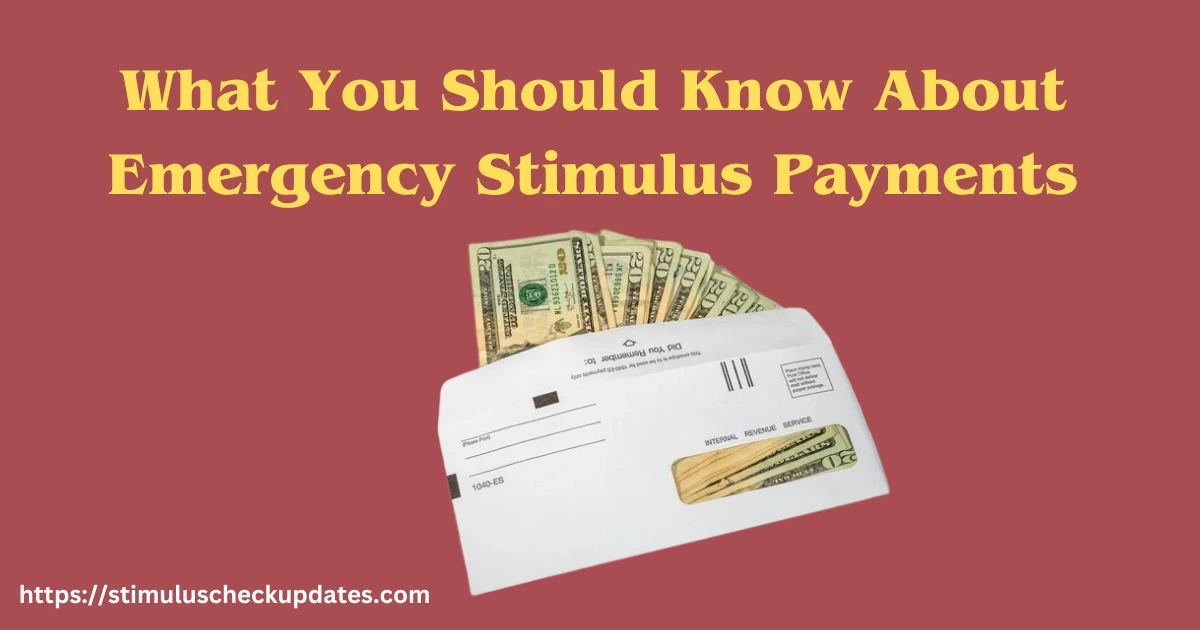In recent years, emergency stimulus payments have become a vital mechanism for governments to support their citizens during times of economic distress. Understanding these payments is crucial for individuals seeking financial relief. In this article, we will explore the intricacies of emergency stimulus payments, including their purpose, qualification requirements, distribution methods, and the implications they have on both individuals and the economy.
Emergency Stimulus Payments
Emergency stimulus payments are immediate financial assistance measures designed to provide monetary relief to individuals and families facing economic hardships. They aim to boost consumer spending, stabilize the economy, and mitigate the adverse effects of economic downturns. Understanding the background and significance of these payments is crucial in navigating financial challenges.

The Purpose of Emergency Stimulus Payments
Economic Stability
One of the primary goals of emergency stimulus payments is to maintain economic stability. By providing financial support to citizens, the government aims to increase consumer spending, which in turn stimulates business activities and promotes job retention.
Immediate Relief
These payments serve as a lifeline for many individuals. They are intended to address urgent needs such as rent, groceries, and other essential expenses that may have become unaffordable due to sudden job loss or reduced income.
Encouragement of Economic Recovery
By injecting money into the economy, emergency stimulus payments help facilitate recovery during economic downturns. This process can lead to increased demand for goods and services, contributing to the overall revitalization of the economy.
Types of Emergency Stimulus Payments
3.1 Direct Payments
Direct payments, often referred to as stimulus checks, are one-time payments made to eligible individuals and families. These payments are usually based on income levels and are designed to provide immediate financial support.
For example, during the COVID-19 pandemic, the federal government issued several rounds of stimulus checks, with amounts varying based on individual or family income. Most eligible adults received payments of $1,200, with additional funds for dependents.
3.2 Tax Credits
Another form of emergency stimulus payments is tax credits, such as the Earned Income Tax Credit (EITC). This credit provides a tax refund to eligible low-to-moderate-income workers, providing them with necessary funds that can be used to cover living expenses.
Tax credits may also be expanded temporarily during emergencies to increase the financial support available to eligible households.
3.3 Unemployment Benefits
Emergency stimulus payments can also come in the form of enhanced unemployment benefits. During times of economic crisis, additional benefits may be provided to individuals who have lost their jobs, ensuring that they have a financial cushion while they search for new employment.
Programs like the Pandemic Unemployment Assistance (PUA) expanded the eligibility for unemployment benefits to include gig workers and independent contractors during the pandemic.
Eligibility for Emergency Stimulus Payments
Criteria for Qualification
Eligibility for emergency stimulus payments can vary based on the specific payment program. However, common criteria typically include:
- Income Level: Most programs set a maximum income threshold to qualify for the payments. For instance, the recent stimulus payments were phased out for individuals earning above 75,000 and couples earning above 150,000.
- Tax Filing Status: Individuals and couples filing their taxes jointly may receive different amounts based on their combined income.
- Citizenship Status: Generally, payments are available to U.S. citizens and certain resident aliens. Non-resident aliens and some dependants (like international students) may not qualify.
Additional Considerations
Certain programs may also have specific requirements, such as proof of employment, age limitations for dependants, or resident requirements. Always check the latest guidelines provided by government sources to understand the exact eligibility criteria.
Stimulus Check Eligibility Guide for 2024 and Beyond
How to Apply for Emergency Stimulus Payments
Tax Returns
In many cases, eligibility for emergency stimulus payments is based on data from tax returns. Individuals who filed their taxes in previous years may automatically receive a payment based on their reported income.
Online Applications
Some states or local programs may require individuals to apply directly. This often includes filling out an online form with relevant financial and personal information.
External Resources
- For federal programs, individuals can visit the IRS Economic Impact Payments page.
- For state-specific programs, check with your local government’s website or the National Association of State Treasurers.
Distribution of Emergency Stimulus Payments
Payment Methods
Emergency stimulus payments can be distributed in several ways, depending on the program. Common methods include:
- Direct Deposit: Many individuals receive payments via direct deposit into their bank accounts, which is the fastest method.
- Paper Checks: For those who have not provided direct deposit information, physical checks may be mailed, which can take longer to arrive.
- Prepaid Debit Cards: In some cases, funds may be loaded onto prepaid debit cards for easier access.
Timing of Payments
Payment timing can vary significantly based on the program. Generally, direct deposits occur faster than mailed checks, and individuals can track the status of their payments through official government websites.
Impact of Emergency Stimulus Payments
Short-Term Benefits
Emergency stimulus payments provide immediate financial relief, helping individuals cover necessary expenses such as housing, food, and medical bills. This support can prevent many from falling into poverty or facing eviction during challenging times.
Long-Term Economic Effects
In addition to immediate relief, these payments can have longer-term impacts on the economy. By stimulating consumer spending, emergency stimulus payments can lead to increased business revenues, job retention, and overall economic growth.
Behavioral Changes
The introduction of emergency stimulus payments can also lead to changes in consumer behavior. Individuals may prioritize spending on essentials, saving for future emergencies, or investing in skills and education for better job opportunities.
Common Questions About Emergency Stimulus Payments
1. How can I check the status of my stimulus payment?
You can check the status of your emergency stimulus payment through the IRS Get My Payment tool.
2. What should I do if I get an incorrect payment amount?
If you believe you have received an incorrect amount, you can look for guidance on how to rectify the issue through the IRS or your local tax authority.
3. Do I need to pay taxes on my stimulus payment?
No, emergency stimulus payments are not considered taxable income and do not need to be reported on your tax return.
Conclusion
Understanding emergency stimulus payments is essential for navigating economic challenges effectively. These payments serve as crucial financial support for individuals and families, aiding in economic stability and recovery during difficult times. As you become familiar with eligibility, application processes, and the variety of payment types available, you can better position yourself to take full advantage of these resources.
For the latest updates on current and future emergency stimulus payments, always refer to reliable government sources and stay informed about your eligibility.
By exploring the information in this article, you can better understand and navigate the landscape of emergency stimulus payments, ensuring that you receive the support that may be available to you.
